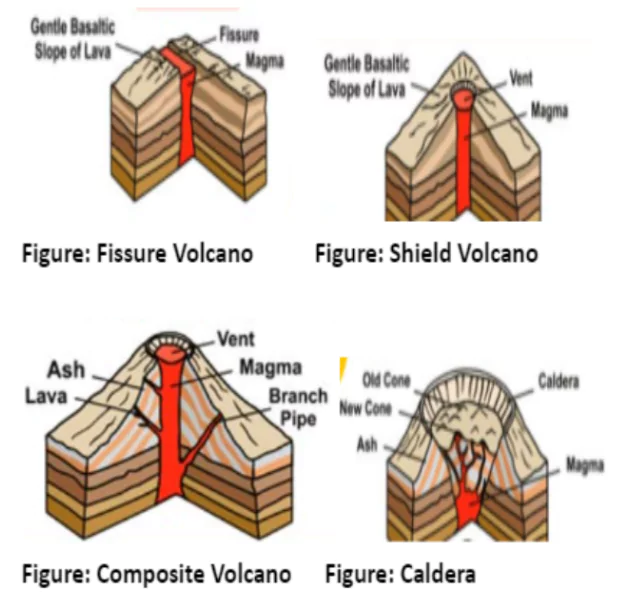Volcanoes are categorized based on how often they erupt, their shape, and the type of eruption they produce. They can be active, dormant, or extinct. They also vary in shape, from gentle shield volcanoes like those in Hawaii to explosive composite volcanoes like Mount Fuji. Eruptions can range from smooth flows of lava, as seen in Icelandic eruptions, to explosions.
What are the volcanoes?
- A volcano is like a crack in the Earth’s surface where hot lava, ash, and gases burst out. Pressure from dissolved gas helps drive volcanic eruptions.
- Deep beneath a volcano, molten magma containing gas rises through cracks in the Earth’s crust. When the magma rises, pressure drops, making the gas form bubbles.
- Lava with low silica flows easily and lets gas escape, but lava with high silica is thick and traps gas inside.
Classification of Volcanoes
Volcanoes can be classified based on various factors, such as their Periodicity level, Viscosity, and Eruption types.
Classification Based on the Periodicity of the Eruption
- Active Volcanoes: Frequent eruptions, often around the Ring of Fire.
- Examples: Mount Stromboli, – Lighthouse of Mediterranean (Italy), Mount St. Helens (US), and Mount Vesuvius (Italy).
- Dormant Volcanoes: These are inactive but can erupt in the future.
- Example: Mount Kilimanjaro ((Tanzania).
- Extinct Volcanoes: have been inactive since the distant past; In most cases, the crater of the volcano is filled with water, forming a lake.
- Example: Emperor seamount chain (Hawaiian), Tamu Massif in the Northwest Pacific Ocean
Enroll now for UPSC Online Course
Classification Based on Viscosity

- Shield Volcanoes: Among the Earth’s largest volcanoes; not very steep;
- Composed mainly of basalt and has low explosivity unless water enters the vent.
- Example: Hawaiian Island.
- Composite Volcanoes: They erupt cooler and more viscous lavas than basalt; explosive eruptions;
- accumulation of these materials near the vent forms layered structures.
- Example: Mount Fuji, Japan.
- Caldera: Among the most explosive volcanoes; tend to collapse post-eruption, forming depressions known as calderas.
- Flood Basalt Provinces: Emit highly fluid lava that can flow over vast distances.
- Example: the Deccan Traps in India.
- Mid-Ocean Ridge Volcanoes: Observed in oceanic regions.
Classification based on the Eruption Types
- Effusive Eruptions: These are characterised by the relatively gentle release of lava, often associated with shield volcanoes.
- Example: Hawaiian Volcanoes.
- Explosive Eruptions: This type of volcano Involves the violent ejection of ash, rock fragments, and gases, leading to pyroclastic flows and ash clouds.
- Examples: Plinian eruptions, like the one that destroyed Pompeii.
Types of Volcanic Eruptions
- Volcanic eruptions can be effusive, with smooth basaltic magma flow, or explosive, characterised by viscous magma causing explosive releases.
- Six primary types include:
- Icelandic: with flowing basaltic lava.
- Hawaiian: forming shield volcanoes.
- Strombolian: with frequent bursts of glowing lava.
- Vulcanian: featuring moderate gas and ash explosions.
- Pelean: being explosive with destructive pyroclastic flows.
- Plinian: the most violent, produces high-speed jet blasts reaching the stratosphere.
Conclusion
Volcanoes come in different types, like active, dormant, or extinct, and they vary in shape and eruption style. Some, like shield volcanoes, erupt gently, while others, like composite volcanoes, explode violently.
![]() April 26, 2024
April 26, 2024
![]() 7600
7600
![]() 0
0
